Experimental Study on Coupling Influence of Temperature and Confining Pressure to Deformation and Strength Characteristics of Rock-like Material with Pre-Existing Crack
Abstract
:1. Introduction
2. Rock-like Material and Testing Procedure
2.1. Rock-like Material
2.2. Testing Procedure
3. Results and Discussion
3.1. Uniaxial Compression Test at Different Temperatures
3.2. Compression Test at Different Temperatures and Confining Pressures
3.2.1. Influences of Temperature and Confining Pressure on Strength and Failure Mode
3.2.2. Effect of Temperature and Confining Pressure on Rock-like Material Parameters
4. Conclusions
- (1)
- Compared with the intact specimen, the strength of the rock-like material with initial crack decreased due to the stress concentration around the tips of the initial crack, which led to the generation of more microcracks around the tips. As observed from the surface of the failure specimen, we can infer that the existence of the initial crack generated new microcracks compared with the intact specimen.
- (2)
- Thermal stress was generated due to the increase in temperature, thereby decreasing the strength and increasing the deformation of the shale-like specimen. This can be attributed to the generation of microcracks inside the specimen, which decreased its compressive capacity. Meanwhile, the deformation of the specimen increased due to the generation of microcracks.
- (3)
- The deformation of the rock-like material was affected by both temperature and confining pressure, but confining pressure was the dominant factor. The failure mode of the rock-like material changed with confining pressure. The failure mode was brittle failure at confining pressures of 0 and 1 MPa, whereas it was plastic failure at confining pressures of 5 and 7 MPa. A confining pressure of 3 MPa was the critical value for the transition from brittle to plastic failure. The influence of temperature on the rock-like material was mainly reflected in the later phase of inelastic deformation under confining pressures of 5 and 7 MPa, leading to an increase in deformation with temperature.
- (4)
- Both strength and deformation were affected by the combined influence of temperature, confining pressure, and initial damage. However, the degree of influence and the mechanism of each factor was different. Temperature decreased the strength and increased the deformation due to the generation of thermal stress. Confining pressure enhanced the strength due to lateral stress restricting the deformation and increased the deformation due to the change in failure mode. Initial crack decreased the strength and exaggerated the deformation due to the stress concentration generating more cracks around the initial tips. Confining pressure and initial crack had a significant influence on the strength and deformation, whereas the influence of temperature was minor.
5. Limitations and Future Works
Author Contributions
Funding
Institutional Review Board Statement
Informed Consent Statement
Data Availability Statement
Acknowledgments
Conflicts of Interest
References
- He, M.C.; Xie, H.P.; Peng, S.P. Study on Rock Mechanics in Deep Mming Engineering. Chin. J. Rock Mech. Eng. 2005, 24, 2803–2813. [Google Scholar]
- Xie, H.P.; Gao, F.; Ju, Y. Research and Development of Rock Mechanics in Deep Ground Engineering. Chin. J. Rock Mech. Eng. 2015, 34, 2161–2178. [Google Scholar]
- Qian, Y.; Jing, H.W.; Gao, W. Investigating the Roles of Included Angle and Loading Condition on the Critical Hydraulic Gradient of Real Rock Fracture Networks. Rock Mech. Rock Eng. 2018, 51, 3167–3177. [Google Scholar]
- Zhang, Y.X.; He, Y.N. Rock Mechanics, 2nd ed.; Architecture & Building Press: Beijing, China, 2008. [Google Scholar]
- Zhang, S.J.; Du, H.M.; Harbor, J. The Effect of Confining Pressure and Water Content on Compressive Strength and Deformation of Ice-Rich Silty Sand. Permafr. Periglac. Process. 2017, 28, 298–305. [Google Scholar] [CrossRef]
- Yang, S.Q.; Ju, Y.; Gao, F.; Gui, Y.L. Strength, Deformability and X-ray Micro-CT Observations of Deeply Buried Marble Under Different Confining Pressures. Rock Mech. Rock Eng. 2016, 49, 4227–4244. [Google Scholar] [CrossRef]
- Meng, L.B.; Li, T.B.; Xu, J. Experimental Study on Influence of Confining Pressure on Shale Mechanical Properties under High Temperature Condition. J. China Coal Soc. 2012, 37, 1829–1833. [Google Scholar]
- Mohamadi, M.; Wan, R.G. Strength and post-peak response of Colorado shale at high pressure and temperature. Int. J. Rock Mech. Min. Sci. 2016, 84, 34–46. [Google Scholar] [CrossRef]
- Burghignoli, A.; Desideri, A.; Miliziano, S. A laboratory study on the thermomechanical behaviour of clayey soils. Can. Geotech. J. 2000, 37, 764–780. [Google Scholar] [CrossRef]
- Cekerevac, C.; Laloui, L. Experimental study of thermal effects on the mechanical behaviour of a clay. Int. J. Numer. Anal. Methods Geomech. 2004, 28, 209–228. [Google Scholar] [CrossRef]
- Masri, M.; Sibai, M.; Shao, J.F. Experimental Study of the Thermomechanical Behavior of the Petroleum Reservoir. J. Confl. Stud. 2008, 27, 11–15. [Google Scholar]
- Xu, X.L.; Gao, F.; Zhang, Z.Z. Research on Mechanical Characteristics and Micropore Structure of Granite under High-Temperature. Chin. J. Geotech. Eng. 2014, 36, 2246–2252. [Google Scholar]
- Zhou, Q.C.; Li, H.B.; Yang, C.H.; Ma, H.S.; Chen, L.J. Experimental study on thermo-mechanical and hydro-mechanical coupling of sandstone for west route of south-to-north water transfer project. Chin. J. Rock Mech. Eng. 2005, 24, 3639–3645. [Google Scholar]
- Fang, Q.; Ruan, Z.; Zhai, C.C. Split Hopkinson Pressure Bar Test and Numerical Analysis of Salt Rock under Confining Pressure and Temperature. Chin. J. Rock Mech. Eng. 2012, 31, 1756–1765. [Google Scholar]
- Rossi, E.; Kant, M.A.; Madonna, C.; Saar, M.O.; von Rohr, P.R. The Effects of High Heating Rate and High Temperature on the Rock Strength: Feasibility Study of a Thermally Assisted Drilling Method. Rock Mech. Rock Eng. 2018, 51, 2957–2964. [Google Scholar] [CrossRef]
- Huang, Y.H.; Yang, S.Q.; Tian, W.L.; Zeng, W.; Yu, L.Y. An experimental study on fracture mechanical behavior of rock-like materials containing two unparallel fissures under uniaxial compression. Acta Mech. Sin. 2016, 32, 442–455. [Google Scholar] [CrossRef]
- Zhou, X.P.; Cheng, H.; Feng, Y.F. An Experimental Study of Crack Coalescence Behaviour in Rock-Like Materials Containing Multiple Flaws Under Uniaxial Compression. Rock Mech. Rock Eng. 2014, 47, 1961–1986. [Google Scholar] [CrossRef]
- Liu, W.T.; Shen, J.J. Experimental Study of Propagation Mode of Crack in Rreal Rrock Specimens with a Single Crack. Chin. J. Rock Mech. Eng. 2016, 35, 1182–1189. [Google Scholar]
- Han, T.L.; Chen, Y.S.; Shi, J.P. Experimental Study of Effect of Stress Path on Mechanical Characteristics of Cracked Samples. Chin. J. Rock Mech. Eng. 2013, 32, 3092–3099. [Google Scholar]
- Zhang, Y.; Li, N.; Yu, H.O. Research on Influence of Thermal Stress on Fractured Rock mass Strength. Chin. J. Rock Mech. Eng. 2013, 32, 2660–2668. [Google Scholar]
- Huang, Y.H.; Yang, S.Q.; Ju, Y. Experimental Study on Mechanical Behavior of Rock-Like Materials Containing Pre-Existing Intermittent Fissures under Triaxial Compression. Chin. J. Rock Mech. Eng. 2016, 38, 1212–1220. [Google Scholar]
- Wang, Y.Y.; Zhang, J.L.; Zhang, Y.B. The Experimental Investigation of Single Fracture Rock Strength Characteristics and Creep Model by Experiment. Sci. Technol. Eng. 2018, 18, 94–100. [Google Scholar]
- Aliabadian, Z.; Sharafisafa, M.; Tahmasebinia, F.; Shen, L. Experimental and numerical investigations on crack development in 3D printed rock-like specimens with pre-existing flaws. Eng. Fract. Mech. 2020, 241, 107396. [Google Scholar] [CrossRef]
- Lin, Q.B.; Cao, P.; Wen, G.P.; Meng, J.J.; Cao, R.H.; Zhao, Z.Y. Crack coalescence in rock-like specimens with two dissimilar layers and pre-existing double parallel joints under uniaxial compression. Int. J. Rock Mech. Min. Sci. 2021, 139, 104621. [Google Scholar] [CrossRef]
- Wang, Y.; Zhu, Y.; Fan, X.; Gan, X.; Guo, P. The experimental study on the damage influence of the porosity on shale similar material. Chin. J. Appl. Mech. 2016, 33, 695–700. [Google Scholar]
- Yuan, L.I.; Wang, Y.Y. Experimental Research on a New Soft Rock-similar Material with Asphalt and Sand. J. Qingdao Univ. Sci. Technol. (Nat. Sci. Ed.) 2014, 35, 510–513. [Google Scholar]
- Yang, S.Q.; Jiang, Y.Z.; Xu, W.Y.; Chen, X.Q. Experimental investigation on strength and failure behavior of pre-cracked marble under conventional triaxial compression. Int. J. Solids Struct. 2008, 45, 4796–4819. [Google Scholar] [CrossRef] [Green Version]
- Wang, Y.; Zhu, S. Study on Strength Characteristics of Fractured Rock Specimens Under Freeze-thaw Cycles. J. Xuzhou Inst. Technol. (Nat. Sci. Ed.) 2018, 33, 25–29. [Google Scholar]
- Jing, F.; Sheng, Q.; Zhang, H.; Luo, W.; Liu, Y. Research on Distribution Rule of Shallow Crustal Geostress in China Mainland. Chin. J. Rock Mech. Eng. 2007, 26, 2056–2062. [Google Scholar]
- Wang, H.; Ge, Q.; Cui, L.; Wang, Y.; Li, J. Investigation of the Effect of Fissure Angle and Temperature on the Strength and Deformation of Rock-like Material. Mater. Sci. Eng. 2020, 780, 052007. [Google Scholar]
- Zhao, Y.S.; Feng, Z.J.; Xi, B.P. Deformation and instability failure of borehole at high temperature and high pressure in Hot Dry Rock exploitation. Renew. Energy 2015, 77, 159–165. [Google Scholar] [CrossRef]
- Schellschmidt, R.; Vosteen, H.D. Influence of temperature on thermal conductivity, thermal capacity and thermal diffusivity for different types of rock. Phys. Chem. Earth 2003, 28, 499–509. [Google Scholar]
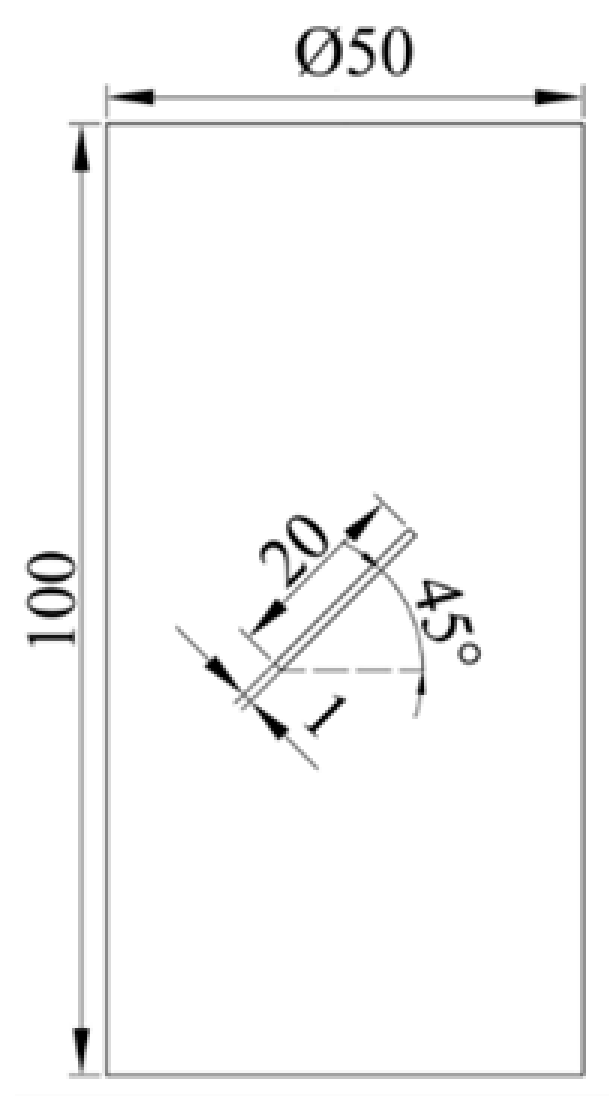

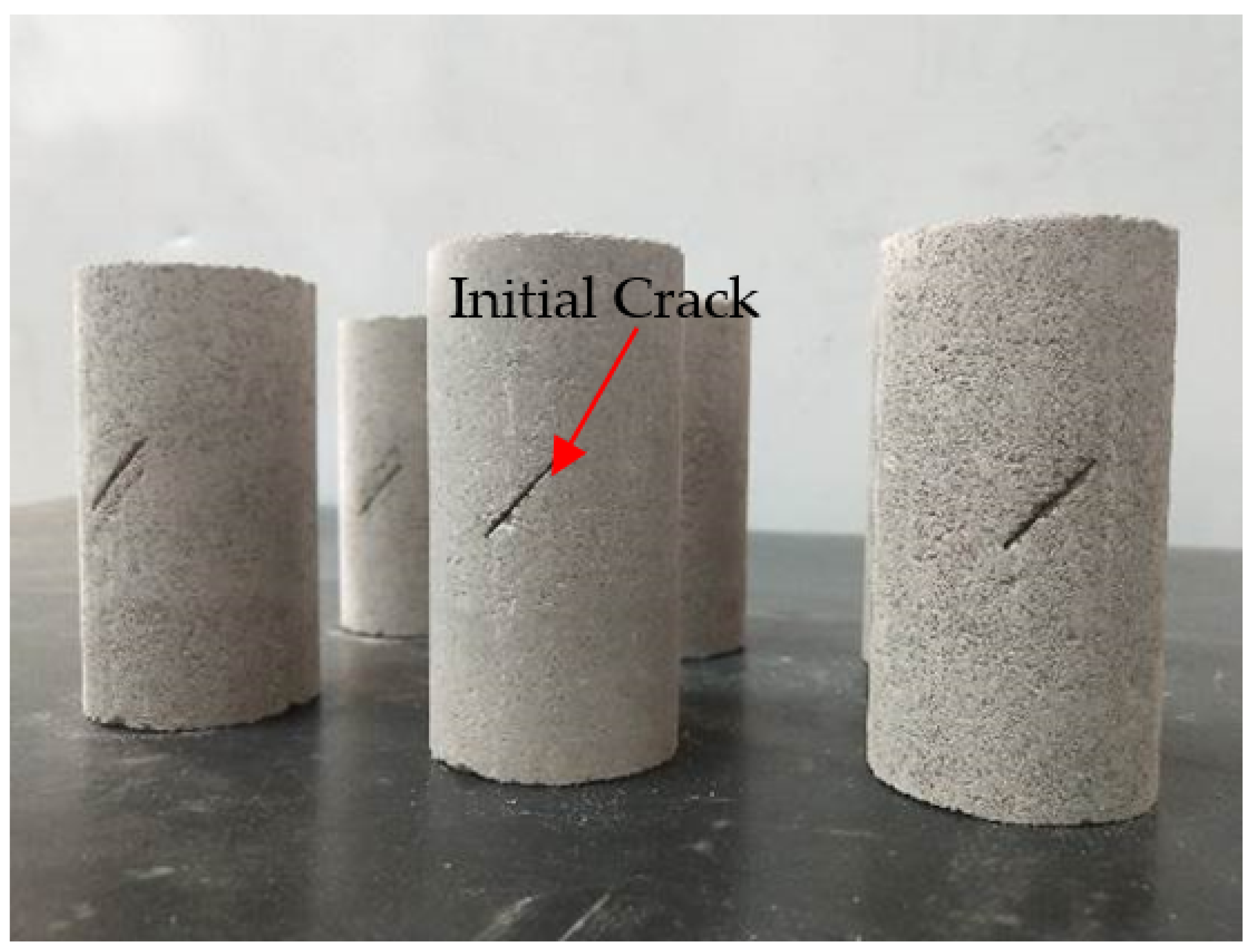


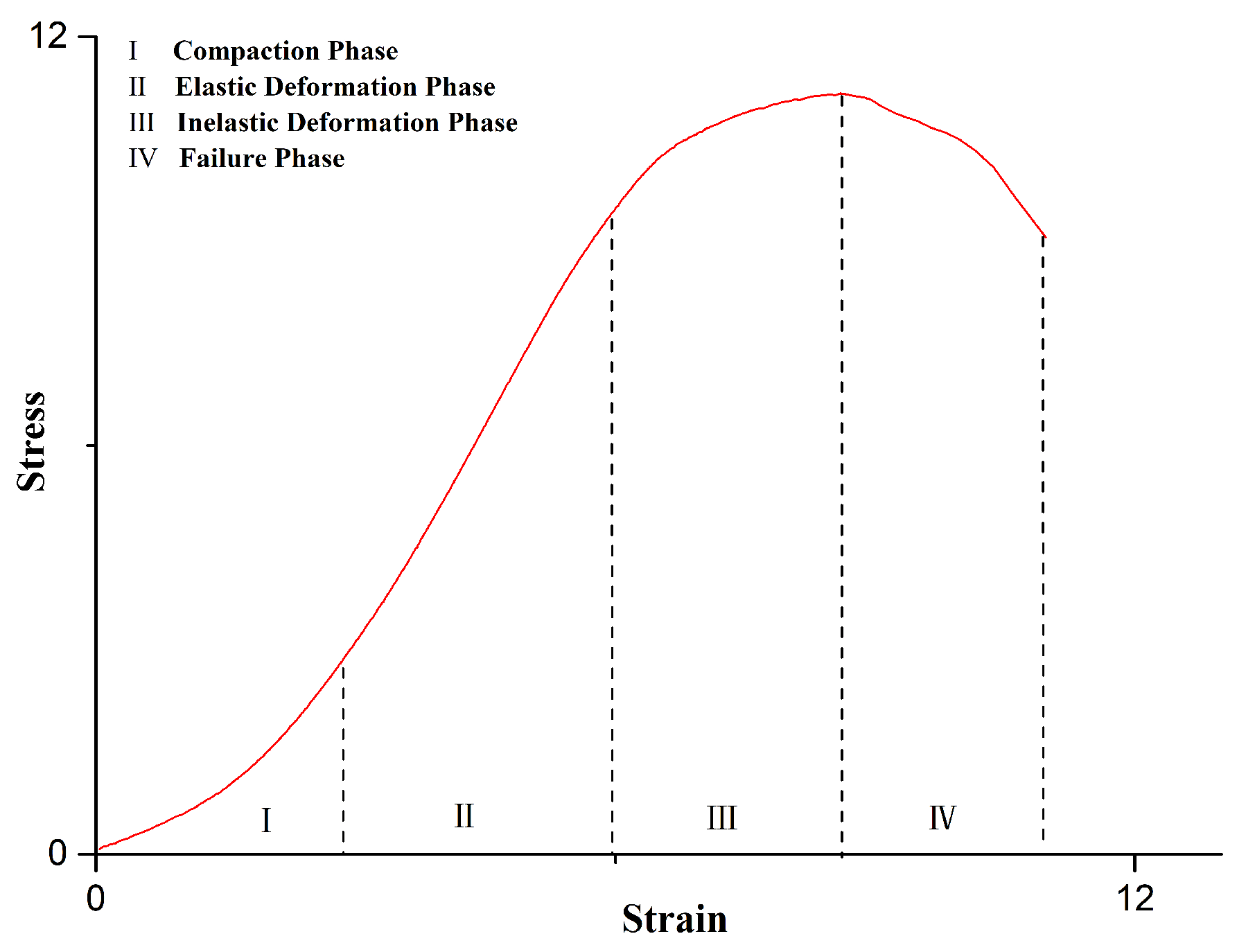
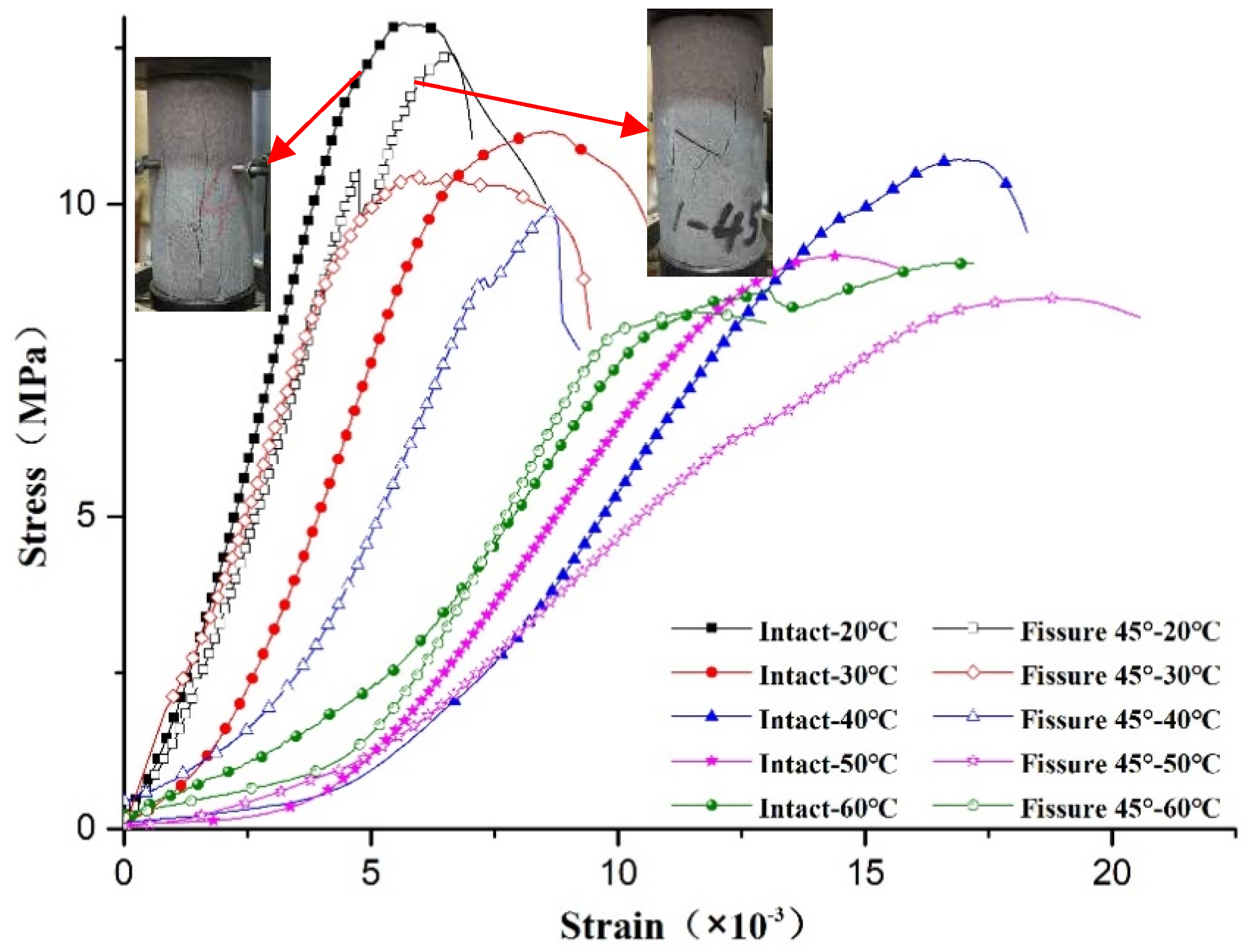
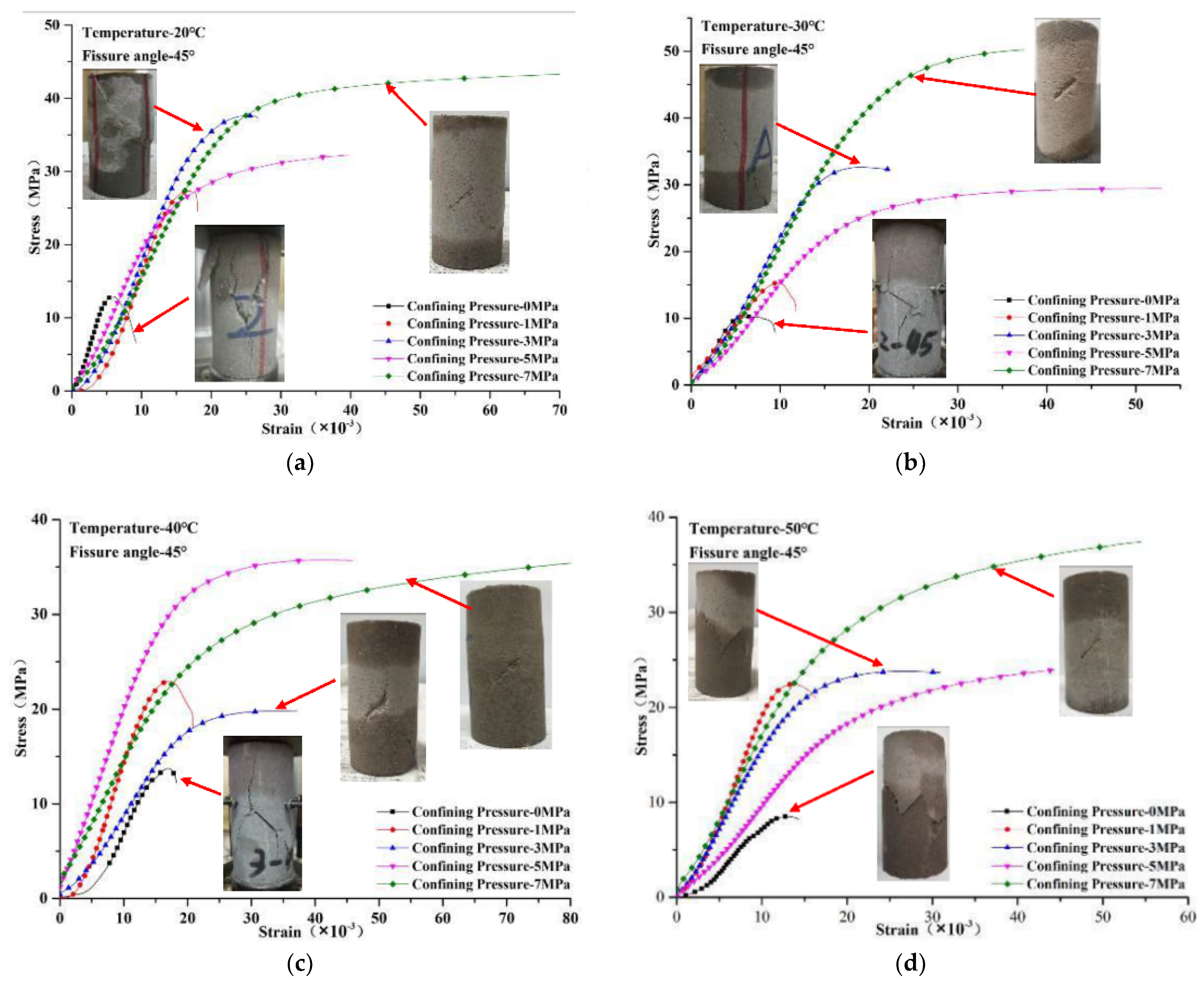
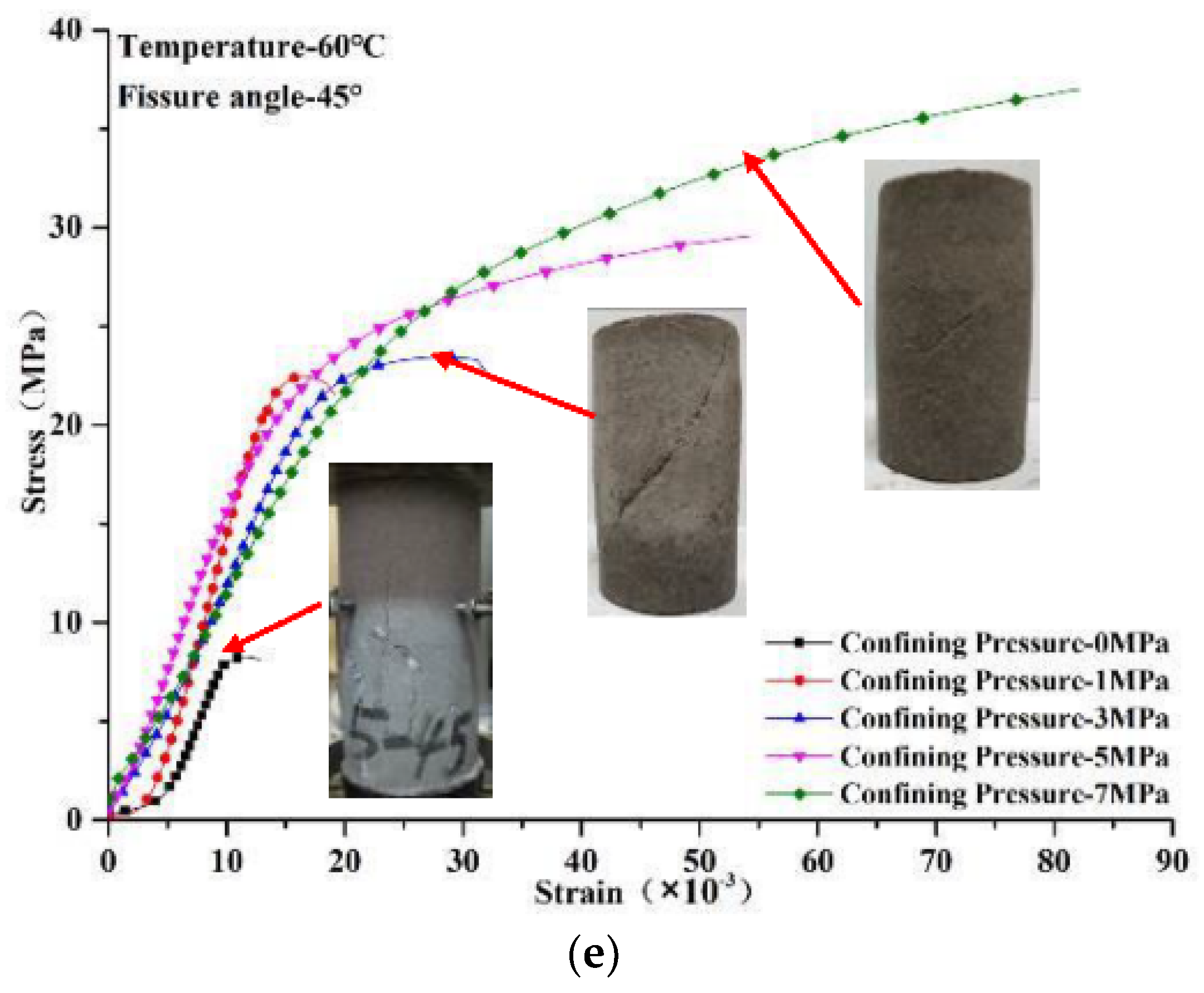

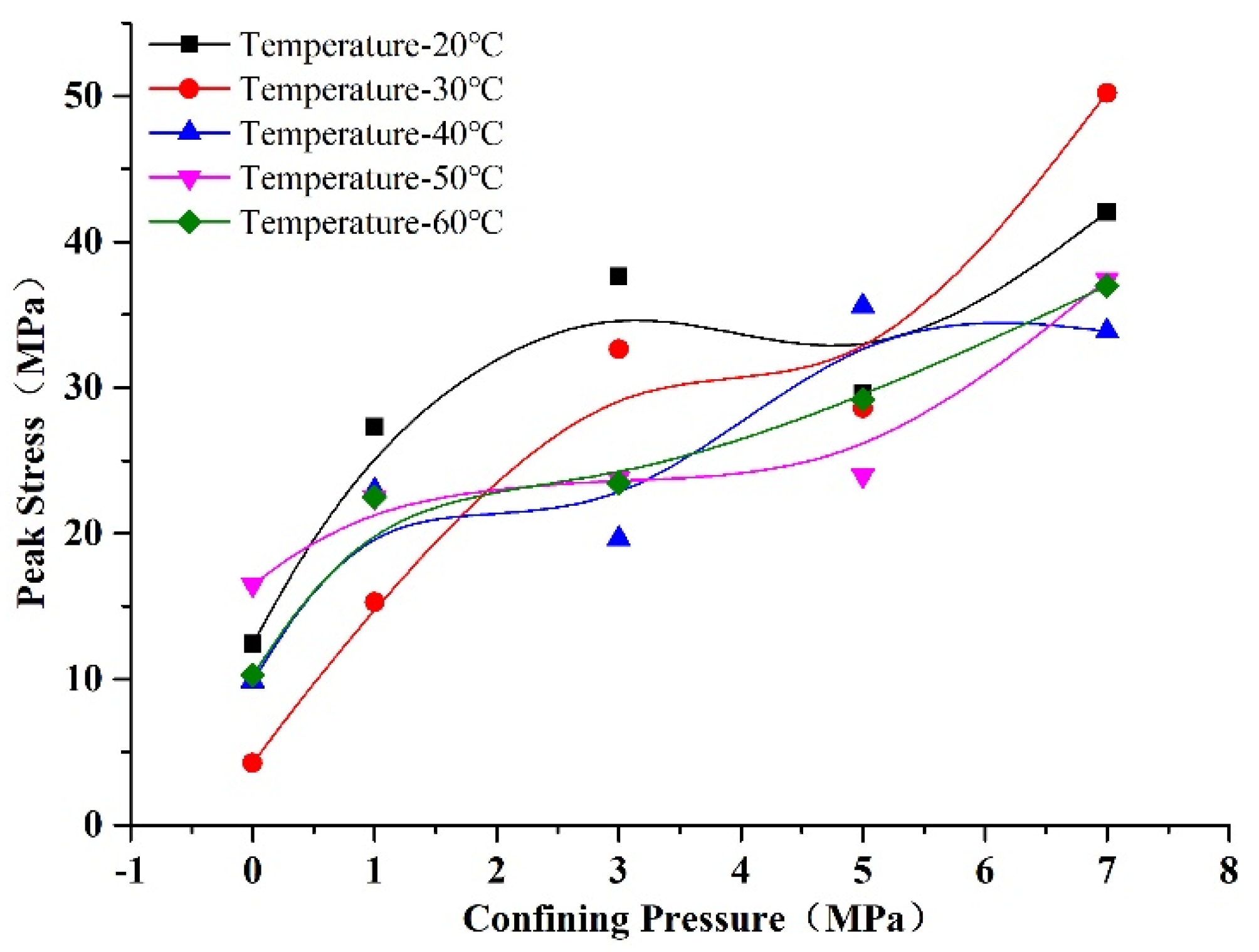
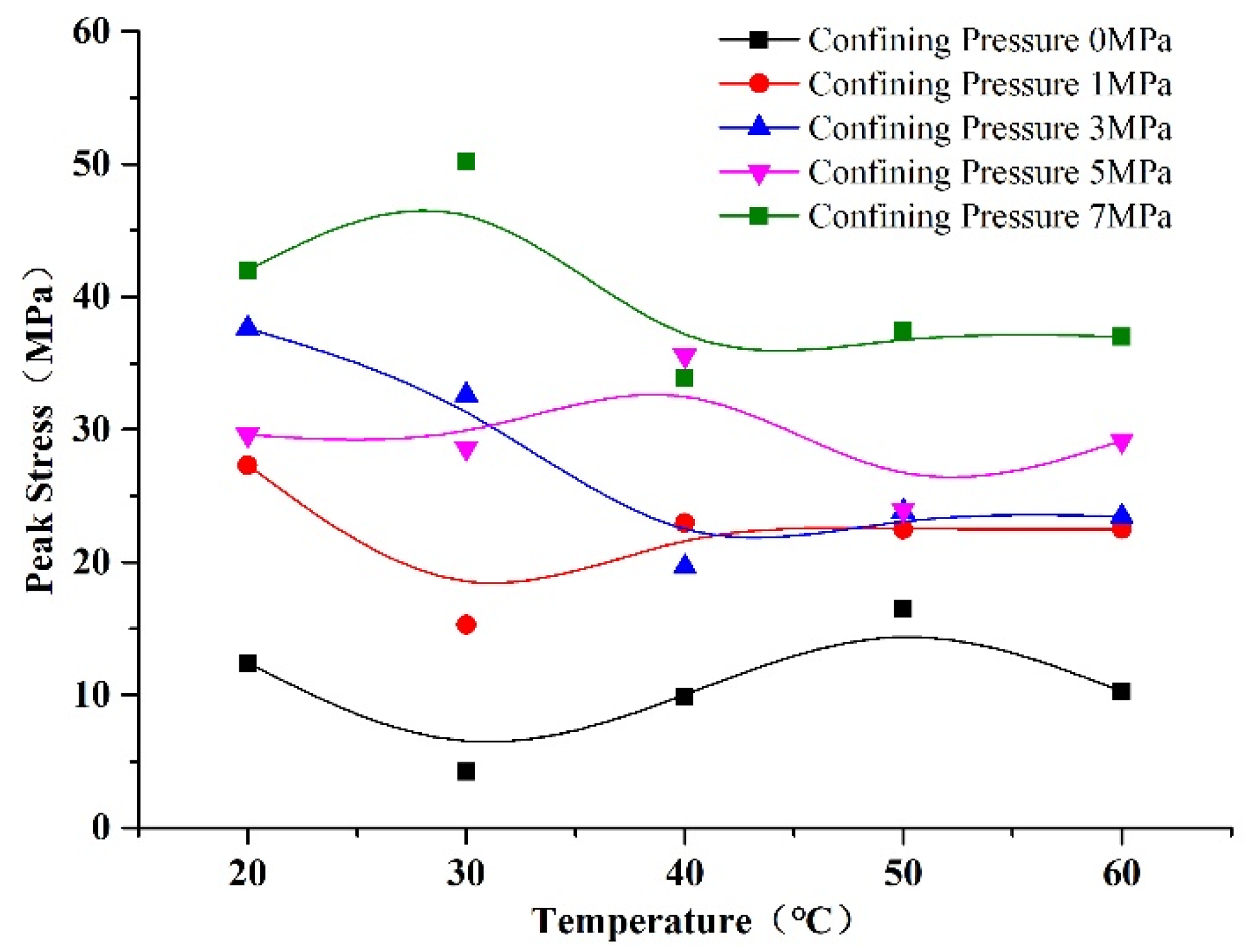
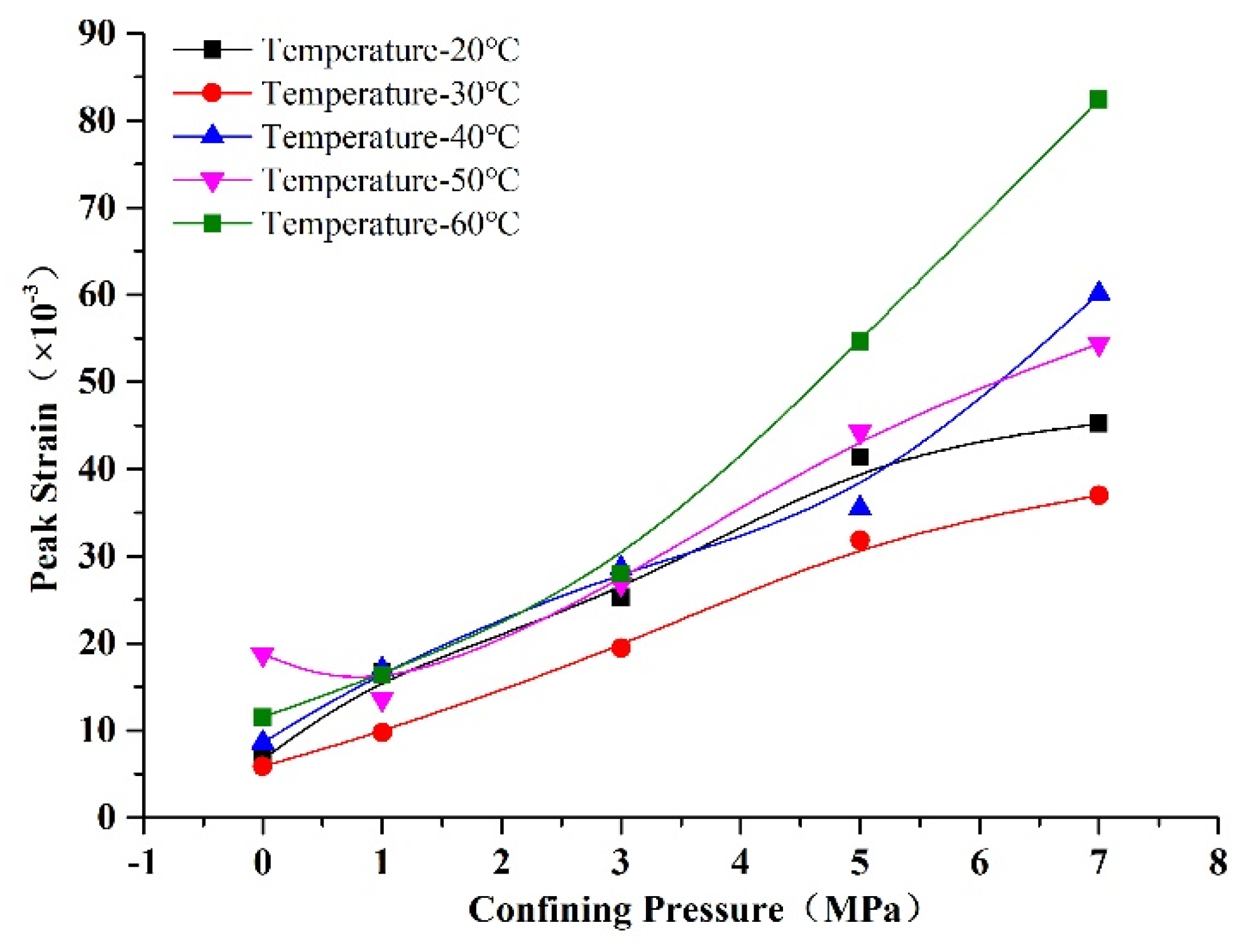
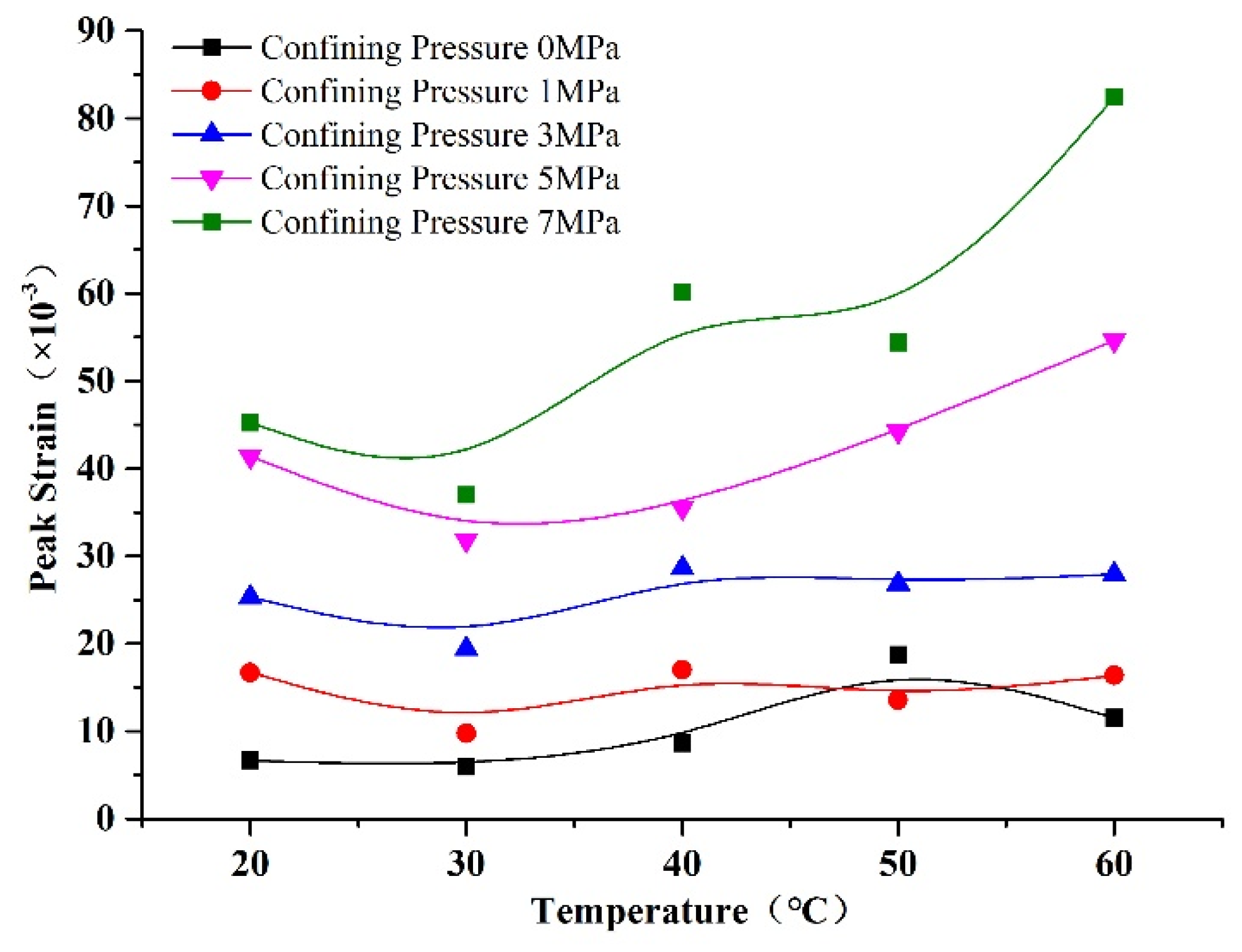
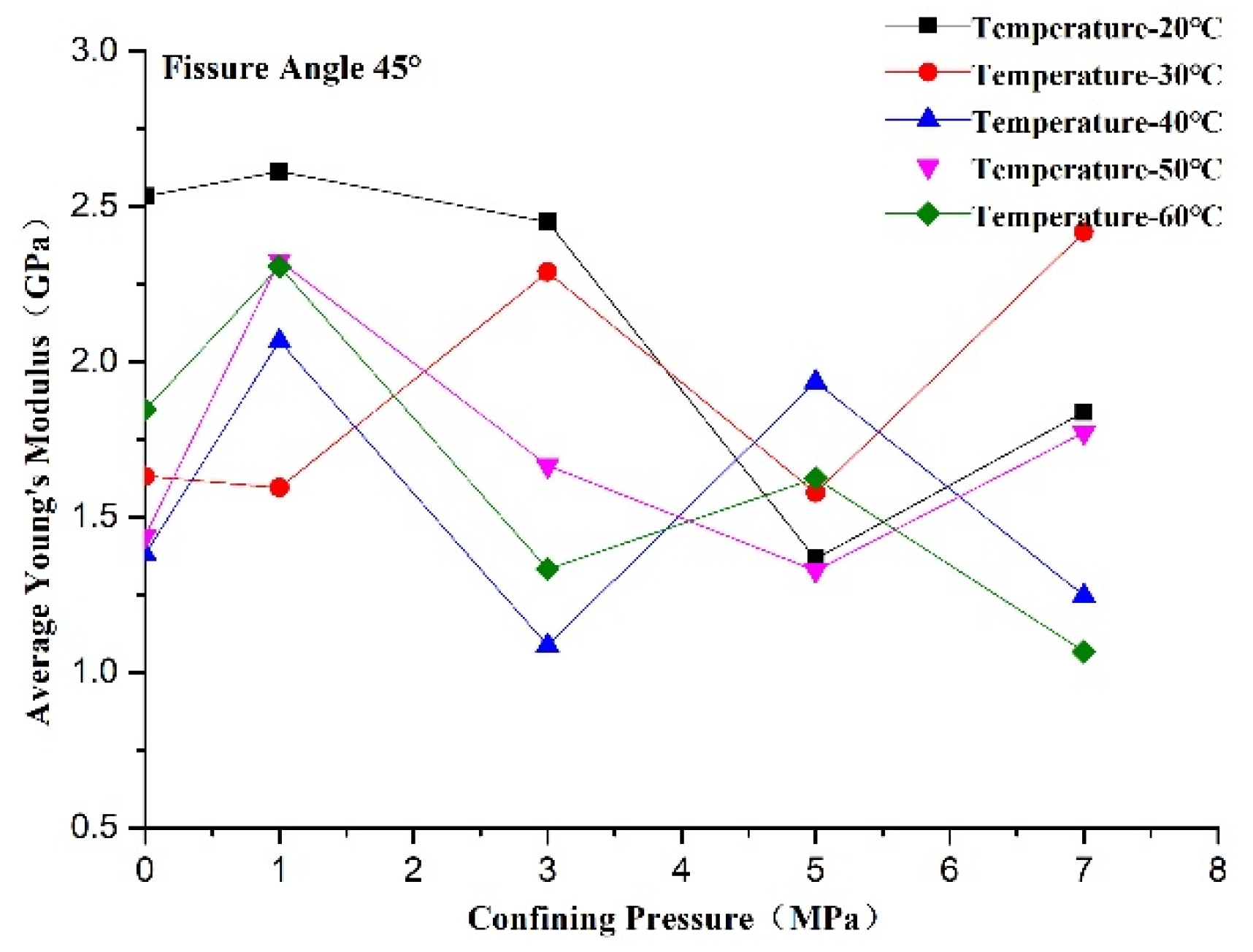
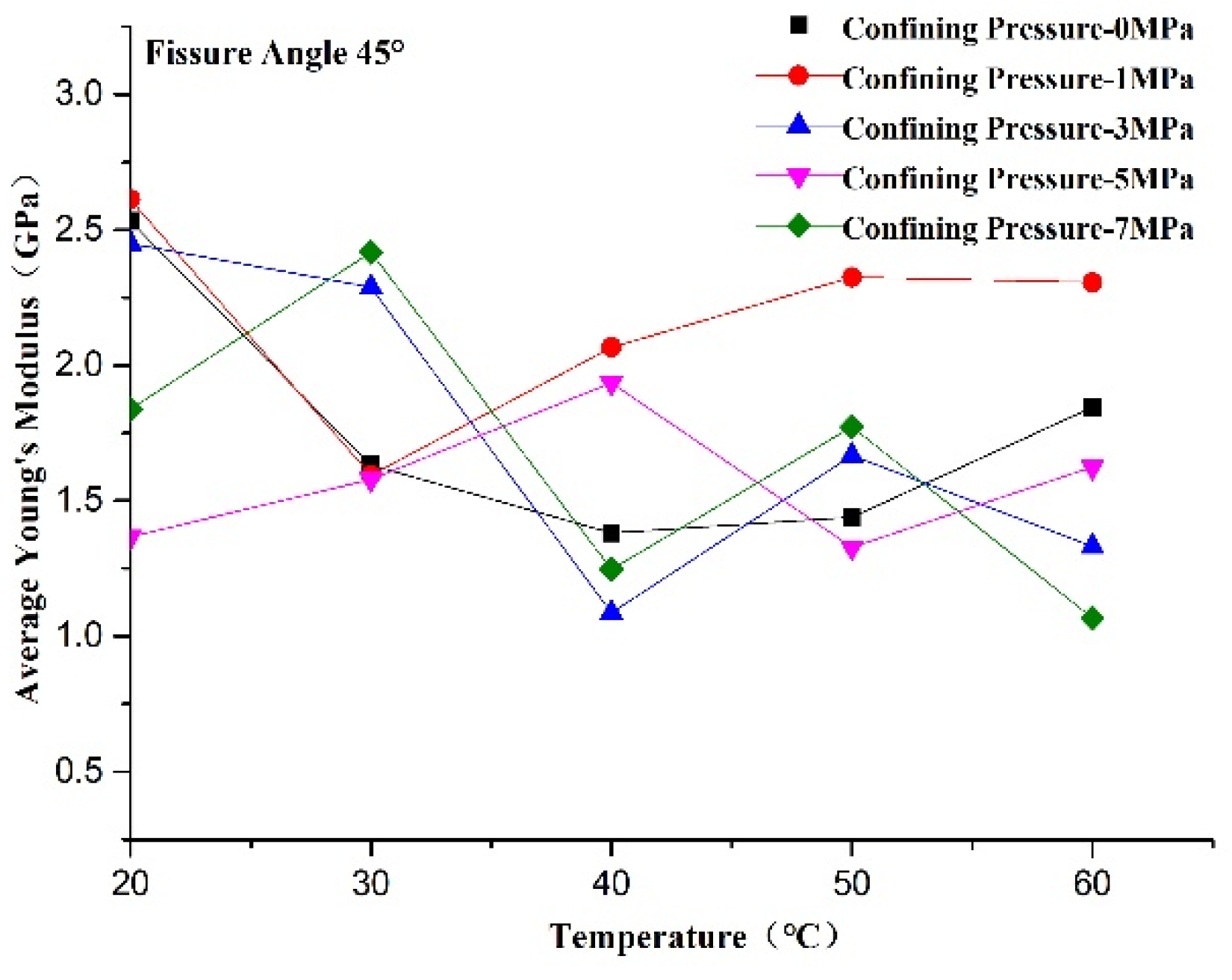
| Parameters | Density (g/cm3) | Young’s Modulus (GPa) | Compressive Strength (MPa) | Internal Friction Angle (°) | Cohesion Force (MPa) | |
|---|---|---|---|---|---|---|
| Class | ||||||
| Parameters of Rock | 1.7–2.5 | 1.0–3.3 | 10–25 | 27–60 | 3.43–46.6 | |
| Parameters of Rock-Like Material a | 1.902 | 1.864 | 12.077 | 32.751 | 4.199 | |
| Specimen Type | 20 °C | 30 °C | 40 °C | 50 °C | 60 °C |
|---|---|---|---|---|---|
| Peak Stress (MPa) | |||||
| Intact Specimen | 12.906 | 11.167 | 10.716 | 9.164 | 9.048 |
| Cracked Specimen * | 12.409 | 10.464 | 9.853 | 8.497 | 8.279 |
Publisher’s Note: MDPI stays neutral with regard to jurisdictional claims in published maps and institutional affiliations. |
© 2021 by the authors. Licensee MDPI, Basel, Switzerland. This article is an open access article distributed under the terms and conditions of the Creative Commons Attribution (CC BY) license (https://creativecommons.org/licenses/by/4.0/).
Share and Cite
Wang, H.; Wang, Y.; Fu, X. Experimental Study on Coupling Influence of Temperature and Confining Pressure to Deformation and Strength Characteristics of Rock-like Material with Pre-Existing Crack. Materials 2021, 14, 7572. https://doi.org/10.3390/ma14247572
Wang H, Wang Y, Fu X. Experimental Study on Coupling Influence of Temperature and Confining Pressure to Deformation and Strength Characteristics of Rock-like Material with Pre-Existing Crack. Materials. 2021; 14(24):7572. https://doi.org/10.3390/ma14247572
Chicago/Turabian StyleWang, Hongwei, Yongyan Wang, and Xi Fu. 2021. "Experimental Study on Coupling Influence of Temperature and Confining Pressure to Deformation and Strength Characteristics of Rock-like Material with Pre-Existing Crack" Materials 14, no. 24: 7572. https://doi.org/10.3390/ma14247572
APA StyleWang, H., Wang, Y., & Fu, X. (2021). Experimental Study on Coupling Influence of Temperature and Confining Pressure to Deformation and Strength Characteristics of Rock-like Material with Pre-Existing Crack. Materials, 14(24), 7572. https://doi.org/10.3390/ma14247572





